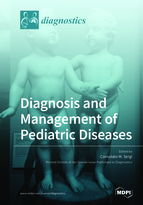Diagnosis and Management of Pediatric Diseases
A special issue of Diagnostics (ISSN 2075-4418). This special issue belongs to the section "Pathology and Molecular Diagnostics".
Deadline for manuscript submissions: closed (15 August 2019) | Viewed by 72577
Special Issue Editor
Interests: gastrointestinal/biliary diseases; metabolic diseases; congenital heart disease; mitochondrial DNA-related cardiomyopathies; carcinogenesis (bone/liver)
Special Issues, Collections and Topics in MDPI journals
Special Issue Information
Dear Colleagues,
The recent progress identified in Neonatal and Pediatric Intensive Care of the last 20 years is astonishing. The possibility of survival of premature babies and newborns with very low weight has increased exponentially. However, the pulmonary and gastrointestinal functions, as well as the immune systems, remain critical. There is an increased rate of infection at this age, and sepsis and cardiovascular function are intimately related and therapy. The procedures of diagnosis in the neonatal settings are overlapping with diagnostic algorithms used at older age, but in any situation, they remain a complex and dynamic process, which requires an accurate medical history, a skilful physical examination, appropriate laboratory tests, and imaging studies with or without anatomo-pathological examination of tissue biopsies. However, even with these tactics and steps forward, clinical diagnosis may frequently remain elusive. It may be a quite long journey from the first appearance of symptom or sign to the final diagnosis. To the physician the impression is that new techniques seem to shorten this journey swiftly. Among the most promising techniques, the next-generation sequencing (NGS) may play a major role in this decade. NGS is becoming more and more used in clinics other than in academia, although one of the most challenging aspects of NGS testing may reside in its analytical validity. The field of metabolomics is indeed almost lightfast developing, particularly in paediatrics. Liquid chromatography mass spectrometry (LC-MS) with nanoflow pre-concentration (nLC−MS) is currently more often used in the proteomic field to investigate minor amounts of both proteins and peptide samples. In metabolomics, just very recently, nLC-MS is becoming to be more accepted completing other advanced lab technologies. This approach is tightly allied with the concept of personalized healthcare and patient management. Over the last few years, it seems that a range of robust assays supporting the pre-clinical detection of pathologies are being established. In clouds and electronic libraries, new biomarkers are being identified for several pathologies in paediatrics. Management of paediatric diseases may become extenuating and the use of single nucleotide polymorphisms for the treatment of some paediatric conditions has been proposed. Paediatric trial networks provide paediatricians, researchers, and agencies with new information on how children may respond to drugs and medications. Off-patent drugs that are lacking data on safety, efficacy, and dosing in the paediatric population may be used and their primary goal is to generate the data showing potential health benefits and findings necessary to produce evidence-based medicine for future guidelines in the clinical practice. The present Special Issue aims at bringing a collection of wet lab research and review articles together to summarize a state of the art, problems and future directions in the diagnosis and management of paediatric diseases and I look forward to peruse your contributions.
Prof. Dr. Consolato Maria Sergi
Guest Editor
Manuscript Submission Information
Manuscripts should be submitted online at www.mdpi.com by registering and logging in to this website. Once you are registered, click here to go to the submission form. Manuscripts can be submitted until the deadline. All submissions that pass pre-check are peer-reviewed. Accepted papers will be published continuously in the journal (as soon as accepted) and will be listed together on the special issue website. Research articles, review articles as well as short communications are invited. For planned papers, a title and short abstract (about 100 words) can be sent to the Editorial Office for announcement on this website.
Submitted manuscripts should not have been published previously, nor be under consideration for publication elsewhere (except conference proceedings papers). All manuscripts are thoroughly refereed through a single-blind peer-review process. A guide for authors and other relevant information for submission of manuscripts is available on the Instructions for Authors page. Diagnostics is an international peer-reviewed open access semimonthly journal published by MDPI.
Please visit the Instructions for Authors page before submitting a manuscript. The Article Processing Charge (APC) for publication in this open access journal is 2600 CHF (Swiss Francs). Submitted papers should be well formatted and use good English. Authors may use MDPI's English editing service prior to publication or during author revisions.
Keywords
- newborn, child
- diagnosis
- biomarkers
- imaging
- biopsy
- histology
- mass spectrometry
- therapy
- management
- clinical trials







